Experimental Characterization and Analysis of the In-Plane Elastic Properties and Interlaminar Fracture Toughness of a 3D-Printed Continuous Carbon Fiber-Reinforced Composite
Abstract
:1. Introduction
2. Materials and Methods
2.1. Manufacturing and Testing of the In-Plane Tensile and Shear Characterization Specimens
2.2. Manufacturing and Testing of the Interlaminar Fracture Toughness Specimens
3. Results
3.1. In-Plane Material Properties
3.2. Interlaminar Fracture Toughness
4. Discussion
4.1. In-Plane Material Properties
4.2. Interlaminar Fracture Toughness Characterization
5. Conclusions
Author Contributions
Funding
Institutional Review Board Statement
Informed Consent Statement
Data Availability Statement
Acknowledgments
Conflicts of Interest
References
- Melenka, G.W.; Schofield, J.S.; Dawson, M.R.; Carey, J.P. Evaluation of Dimensional Accuracy and Material Properties of the MakerBot 3D Desktop Printer. Rapid Prototyp. J. 2015, 21, 618–627. [Google Scholar] [CrossRef]
- Gao, W.; Zhang, Y.; Ramanujan, D.; Ramani, K.; Chen, Y.; Williams, C.B.; Wang, C.C.L.; Shin, Y.C.; Zhang, S.; Zavattieri, P.D. The Status, Challenges, and Future of Additive Manufacturing in Engineering. CAD Comput. Aided Des. 2015, 69, 65–89. [Google Scholar] [CrossRef]
- Parandoush, P.; Lin, D. A Review on Additive Manufacturing of Polymer-Fiber Composites. Compos. Struct. 2017, 182, 36–53. [Google Scholar] [CrossRef]
- Wang, X.; Jiang, M.; Zhou, Z.; Gou, J.; Hui, D. 3D Printing of Polymer Matrix Composites: A Review and Prospective. Compos. Part B Eng. 2017, 110, 442–458. [Google Scholar] [CrossRef]
- Chacón, J.M.; Caminero, M.A.; García-Plaza, E.; Núñez, P.J. Additive Manufacturing of PLA Structures Using Fused Deposition Modelling: Effect of Process Parameters on Mechanical Properties and Their Optimal Selection. Mater. Des. 2017, 124, 143–157. [Google Scholar] [CrossRef]
- Love, L.J.; Kunc, V.; Rios, O.; Duty, C.E.; Elliott, A.M.; Post, B.K.; Smith, R.J.; Blue, C.A. The Importance of Carbon Fiber to Polymer Additive Manufacturing. J. Mater. Res. 2014, 29, 1893–1898. [Google Scholar] [CrossRef] [Green Version]
- DeNardo, N.M. Additive Manufacturing of Carbon Fiber-Reinforced Thermoplastic Composites. Ph.D. Thesis, Purdue University, West Lafayette, IN, USA, 2016. [Google Scholar]
- Ning, F.; Cong, W.; Qiu, J.; Wei, J.; Wang, S. Additive Manufacturing of Carbon Fiber Reinforced Thermoplastic Composites Using Fused Deposition Modeling. Compos. Part B Eng. 2015, 80, 369–378. [Google Scholar] [CrossRef]
- Compton, B.G.; Lewis, J.A. 3D-Printing of Lightweight Cellular Composites. Adv. Mater. 2014, 26, 5930–5935. [Google Scholar] [CrossRef]
- Torrado Perez, A.R.; Roberson, D.A.; Wicker, R.B. Fracture Surface Analysis of 3D-Printed Tensile Specimens of Novel ABS-Based Materials. J. Fail. Anal. Prev. 2014, 14, 343–353. [Google Scholar] [CrossRef]
- Duty, C.E.; Kunc, V.; Compton, B.; Post, B.; Erdman, D.; Smith, R.; Lind, R.; Lloyd, P.; Love, L. Structure and Mechanical Behavior of Big Area Additive Manufacturing (BAAM) Materials. Rapid Prototyp. J. 2017, 23, 181–189. [Google Scholar] [CrossRef]
- Ferreira, R.T.L.; Amatte, I.C.; Dutra, T.A.; Bürger, D. Experimental Characterization and Micrography of 3D Printed PLA and PLA Reinforced with Short Carbon Fibers. Compos. Part B Eng. 2017, 124, 88–100. [Google Scholar] [CrossRef]
- Melenka, G.W.; Cheung, B.K.O.; Schofield, J.S.; Dawson, M.R.; Carey, J.P. Evaluation and Prediction of the Tensile Properties of Continuous Fiber-Reinforced 3D Printed Structures. Compos. Struct. 2016, 153, 866–875. [Google Scholar] [CrossRef]
- Dickson, A.N.; Barry, J.N.; McDonnell, K.A.; Dowling, D.P. Fabrication of Continuous Carbon, Glass and Kevlar Fibre Reinforced Polymer Composites Using Additive Manufacturing. Addit. Manuf. 2017, 16, 146–152. [Google Scholar] [CrossRef]
- Van Der Klift, F.; Koga, Y.; Todoroki, A.; Ueda, M.; Hirano, Y. 3D Printing of Continuous Carbon Fibre Reinforced Thermo-Plastic (CFRTP) Tensile Test Specimens. Open J. Compos. Mater. 2016, 6, 18–27. [Google Scholar] [CrossRef] [Green Version]
- Chacón, J.M.; Caminero, M.A.; García-Plaza, E.; Nuñez, P.J.; Garcia-Moreno, I.; Reverte, J.M. Additive Manufacturing of Continuous Fibre Reinforced Thermoplastic Composites Using Fused Deposition Modelling: Effect of Process Parameters on Mechanical Properties. Compos. Sci. Technol. 2018, 181, 107688. [Google Scholar] [CrossRef]
- Young, D.; Wetmore, N.; Czabaj, M. Interlayer Fracture Toughness of Additively Manufactured Unreinforced and Carbon-Fiber-Reinforced Acrylonitrile Butadiene Styrene. Addit. Manuf. 2018, 22, 508–515. [Google Scholar] [CrossRef]
- Kabir, S.M.F.; Mathur, K.; Seyam, A.F.M. A Critical Review on 3D Printed Continuous Fiber-Reinforced Composites: History, Mechanism, Materials and Properties. Compos. Struct. 2020, 232, 111476. [Google Scholar] [CrossRef]
- Brenken, B.; Barocio, E.; Favaloro, A.; Kunc, V.; Pipes, R.B. Fused Filament Fabrication of Fiber-Reinforced Polymers: A Review. Addit. Manuf. 2018, 21, 1–16. [Google Scholar] [CrossRef]
- Heidari-Rarani, M.; Rafiee-Afarani, M.; Zahedi, A.M. Mechanical Characterization of FDM 3D Printing of Continuous Carbon Fiber Reinforced PLA Composites. Compos. Part B Eng. 2019, 175, 107147. [Google Scholar] [CrossRef]
- Matsuzaki, R.; Ueda, M.; Namiki, M.; Jeong, T.K.; Asahara, H.; Horiguchi, K.; Nakamura, T.; Todoroki, A.; Hirano, Y. Three-Dimensional Printing of Continuous-Fiber Composites by in-Nozzle Impregnation. Sci. Rep. 2016, 6, 23058. [Google Scholar] [CrossRef]
- Caminero, M.A.; Chacón, J.M.; García-Moreno, I.; Reverte, J.M. Interlaminar Bonding Performance of 3D Printed Continuous Fibre Reinforced Thermoplastic Composites Using Fused Deposition Modelling. Polym. Test. 2018, 68, 415–423. [Google Scholar] [CrossRef]
- Caminero, M.A.; Chacón, J.M.; García-Moreno, I.; Rodríguez, G.P. Impact Damage Resistance of 3D Printed Continuous Fibre Reinforced Thermoplastic Composites Using Fused Deposition Modelling. Compos. Part B Eng. 2018, 148, 93–103. [Google Scholar] [CrossRef]
- Markforged. Available online: https://markforged.com/composites/ (accessed on 25 February 2020).
- Anisoprint. Available online: https://anisoprint.com/ (accessed on 25 February 2020).
- Naranjo-Lozada, J.; Ahuett-Garza, H.; Orta-Castañón, P.; Verbeeten, W.M.H.; Sáiz-González, D.; Lozada, J.N.; Ahuett-Garza, H.; Castañón, P.O.; Verbeeten, W.M.H.; González, D.S. Tensile Properties and Failure Behavior of Chopped and Continuous Carbon Fiber Composites Produced by Additive Manufacturing. Addit. Manuf. 2019, 26, 227–241. [Google Scholar] [CrossRef]
- Iragi, M.; Pascual-González, C.; Esnaola, A.; Lopes, C.S.; Aretxabaleta, L. Ply and Interlaminar Behaviours of 3D Printed Continuous Carbon Fibre-Reinforced Thermoplastic Laminates; Effects of Processing Conditions and Microstructure. Addit. Manuf. 2019, 30, 100884. [Google Scholar] [CrossRef] [Green Version]
- Goh, G.D.; Dikshit, V.; Nagalingam, A.P.; Goh, G.L.; Agarwala, S.; Sing, S.L.; Wei, J.; Yeong, W.Y. Characterization of Mechanical Properties and Fracture Mode of Additively Manufactured Carbon Fiber and Glass Fiber Reinforced Thermoplastics. Mater. Des. 2018, 137, 79–89. [Google Scholar] [CrossRef]
- Pyl, L.; Kalteremidou, K.A.; Van Hemelrijck, D. Exploration of Specimen Geometry and Tab Configuration for Tensile Testing Exploiting the Potential of 3D Printing Freeform Shape Continuous Carbon Fibre-Reinforced Nylon Matrix Composites. Polym. Test. 2018, 71, 318–328. [Google Scholar] [CrossRef]
- Namiki, M.; Ueda, M.; Todoroki, A.; Hirano, Y.; Matsuzaki, R. 3D Printing of Continuous Fiber Reinforced Plastic. In Proceedings of the International SAMPE Technical Conference, Seattle, WA, USA, 2–5 June 2014. [Google Scholar]
- Blok, L.G.; Longana, M.L.; Yu, H.; Woods, B.K.S. An Investigation into 3D Printing of Fibre Reinforced Thermoplastic Composites. Addit. Manuf. 2018, 22, 176–186. [Google Scholar] [CrossRef]
- Justo, J.; Távara, L.; García-Guzmán, L.; París, F. Characterization of 3D Printed Long Fibre Reinforced Composites. Compos. Struct. 2018, 185, 537–548. [Google Scholar] [CrossRef]
- Chabaud, G.; Castro, M.; Denoual, C.; Le Duigou, A. Hygromechanical Properties of 3D Printed Continuous Carbon and Glass Fibre Reinforced Polyamide Composite for Outdoor Structural Applications. Addit. Manuf. 2019, 26, 94–105. [Google Scholar] [CrossRef]
- Todoroki, A.; Oasada, T.; Mizutani, Y.; Suzuki, Y.; Ueda, M.; Matsuzaki, R.; Hirano, Y. Tensile Property Evaluations of 3D Printed Continuous Carbon Fiber Reinforced Thermoplastic Composites. Adv. Compos. Mater. 2020, 29, 147–162. [Google Scholar] [CrossRef]
- Yogeshvaran, R.N.; Liu, B.G.; Farukh, F.; Kandan, K. Out-of-Plane Compressive Response of Additively Manufactured Cross-Ply Composites. J. Mech. 2020, 36, 197–211. [Google Scholar] [CrossRef]
- ASTM D638-14; Standard Test Method for Tensile Properties of Plastics. Annual Book ASTM Standard: West Conshohocken, PA, USA, 2014; pp. 1–17. [CrossRef]
- Croccolo, D.; De Agostinis, M.; Olmi, G. Experimental Characterization and Analytical Modelling of the Mechanical Behaviour of Fused Deposition Processed Parts Made of ABS-M30. Comput. Mater. Sci. 2013, 79, 506–518. [Google Scholar] [CrossRef]
- ASTM D3039/D3039M-17; Standard Test Method for Tensile Properties of Polymer Matrix Composite Materials. Annual Book ASTM Standard: West Conshohocken, PA, USA, 2017. [CrossRef]
- Caminero, M.A.; García-Moreno, I.; Rodríguez, G.P.; Chacón, J.M. Internal Damage Evaluation of Composite Structures Using Phased Array Ultrasonic Technique: Impact Damage Assessment in CFRP and 3D Printed Reinforced Composites. Compos. Part B Eng. 2019, 165, 131–142. [Google Scholar] [CrossRef]
- Aliheidari, N.; Tripuraneni, R.; Ameli, A.; Nadimpalli, S. Fracture Resistance Measurement of Fused Deposition Modeling 3D Printed Polymers. Polym. Test. 2017, 60, 94–101. [Google Scholar] [CrossRef]
- ASTM D5528-13; Standard Test Method for Mode I Interlaminar Fracture Toughness of Unidirectional Fibre-Reinforced Polymer Matrix Composites. Annual Book ASTM Standard: West Conshohocken, PA, USA, 2013. [CrossRef]
- Khudiakova, A.; Arbeiter, F.; Spoerk, M.; Wolfahrt, M.; Godec, D.; Pinter, G. Inter-Layer Bonding Characterisation between Materials with Different Degrees of Stiffness Processed by Fused Filament Fabrication. Addit. Manuf. 2019, 28, 184–193. [Google Scholar] [CrossRef]
- Fonseca, J.; Ferreira, I.A.; de Moura, M.F.S.F.; Machado, M.; Alves, J.L. Study of the Interlaminar Fracture under Mode I Loading on FFF Printed Parts. Compos. Struct. 2019, 214, 316–324. [Google Scholar] [CrossRef]
- ASTM D7905; Standard Test Method for Determination of the Mode II Interlaminar Fracture Toughness of Unidirectional Fiber-Reinforced Polymer Matrix Composites. Annual Book ASTM Standard: West Conshohocken, PA, USA, 2014; pp. 1–18. [CrossRef]
- Farmand-Ashtiani, E.; Cugnoni, J.; Botsis, J. Specimen Thickness Dependence of Large Scale Fiber Bridging in Mode I Interlaminar Fracture of Carbon Epoxy Composite. Int. J. Solids Struct. 2015, 55, 58–65. [Google Scholar] [CrossRef]
- Ashok Kumar, P.; Ravinder Reddy, P.; Gupta, A. Thickness Effect of DCB Specimen on Interlaminar Fracture Toughness in Carbon/Epoxy Composites. Int. J. Mech. Prod. Eng. Res. Dev. 2018, 8, 541–548. [Google Scholar] [CrossRef]
- Pickering, K.L.; Efendy, M.G.A.; Le, T.M. A Review of Recent Developments in Natural Fibre Composites and Their Mechanical Performance. Compos. Part A Appl. Sci. Manuf. 2016, 83, 98–112. [Google Scholar] [CrossRef] [Green Version]
- Pai, C.-C.; Jeng, R.-J.; Grossman, S.J.; Huang, J.-C. Effects of Moisture on Thermal and Mechanical Properties of Nylon-6,6. Adv. Polym. Technol. 1989, 9, 157–163. [Google Scholar] [CrossRef]
- Jia, N.; Fraenkel, H.A.; Kagan, V.A. Effects of Moisture Conditioning Methods on Mechanical Properties of Injection Molded Nylon 6. J. Reinf. Plast. Compos. 2004, 23, 729–737. [Google Scholar] [CrossRef]
- ISO-15024; Fibre-Reinforced Plastic Composites-Determination of Mode I Interlaminar Fracture Toughness, GIc, for Unidirectionally Reinforced Materials. International Organization for Standardization: Geneva, Switzerland, 2001.
- ISO 15114:2014; Fibre-Reinforced Plastic Composites-Determination of the Mode II Fracture Resistance for Unidirectionally Reinforced Materials Using the Calibrated End-Loaded Split (C-ELS) Test and an Effective Crack Length Approach. International Organization for Standardization: Geneva, Switzerland, 2014; Volume 2014, pp. 1–26.
- Paris, A.J.; Paris, P.C. Instantaneous Evaluation of J and C. Int. J. Fract. 1988, 38, R19–R21. [Google Scholar] [CrossRef]
- Sarrado, C.; Turon, A.; Costa, J.; Renart, J. On the Validity of Linear Elastic Fracture Mechanics Methods to Measure the Fracture Toughness of Adhesive Joints. Int. J. Solids Struct. 2016, 81, 110–116. [Google Scholar] [CrossRef]


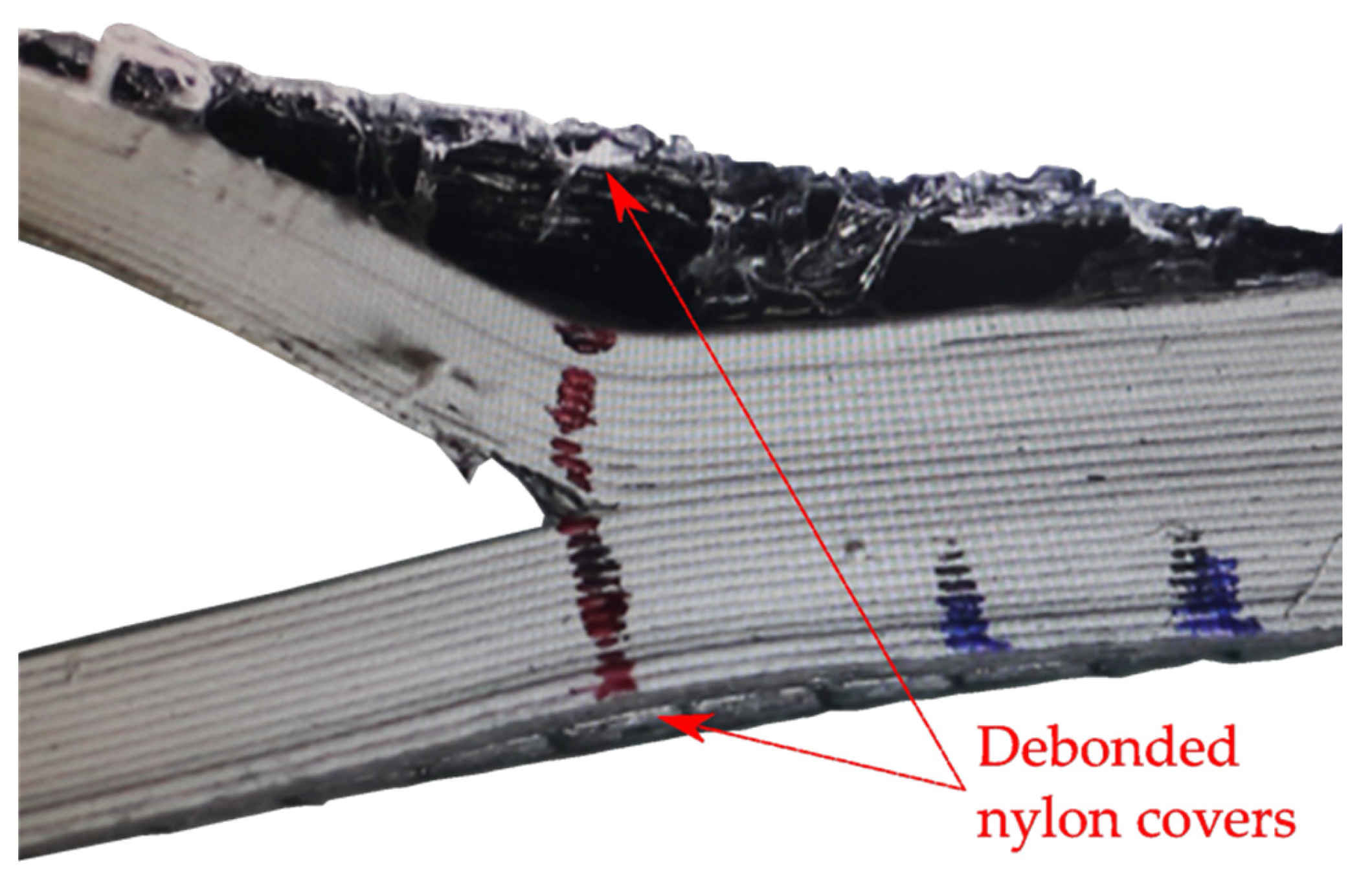
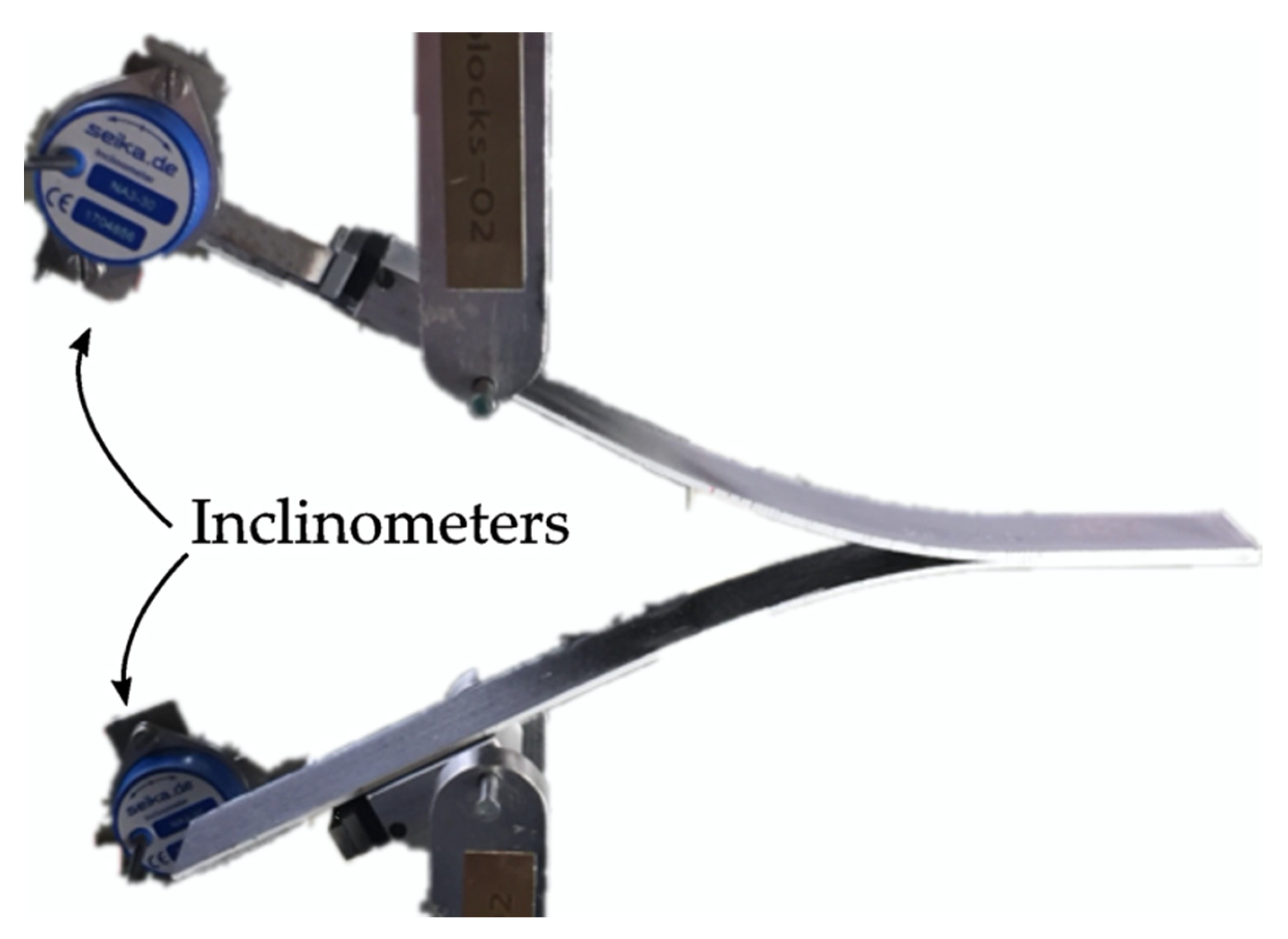
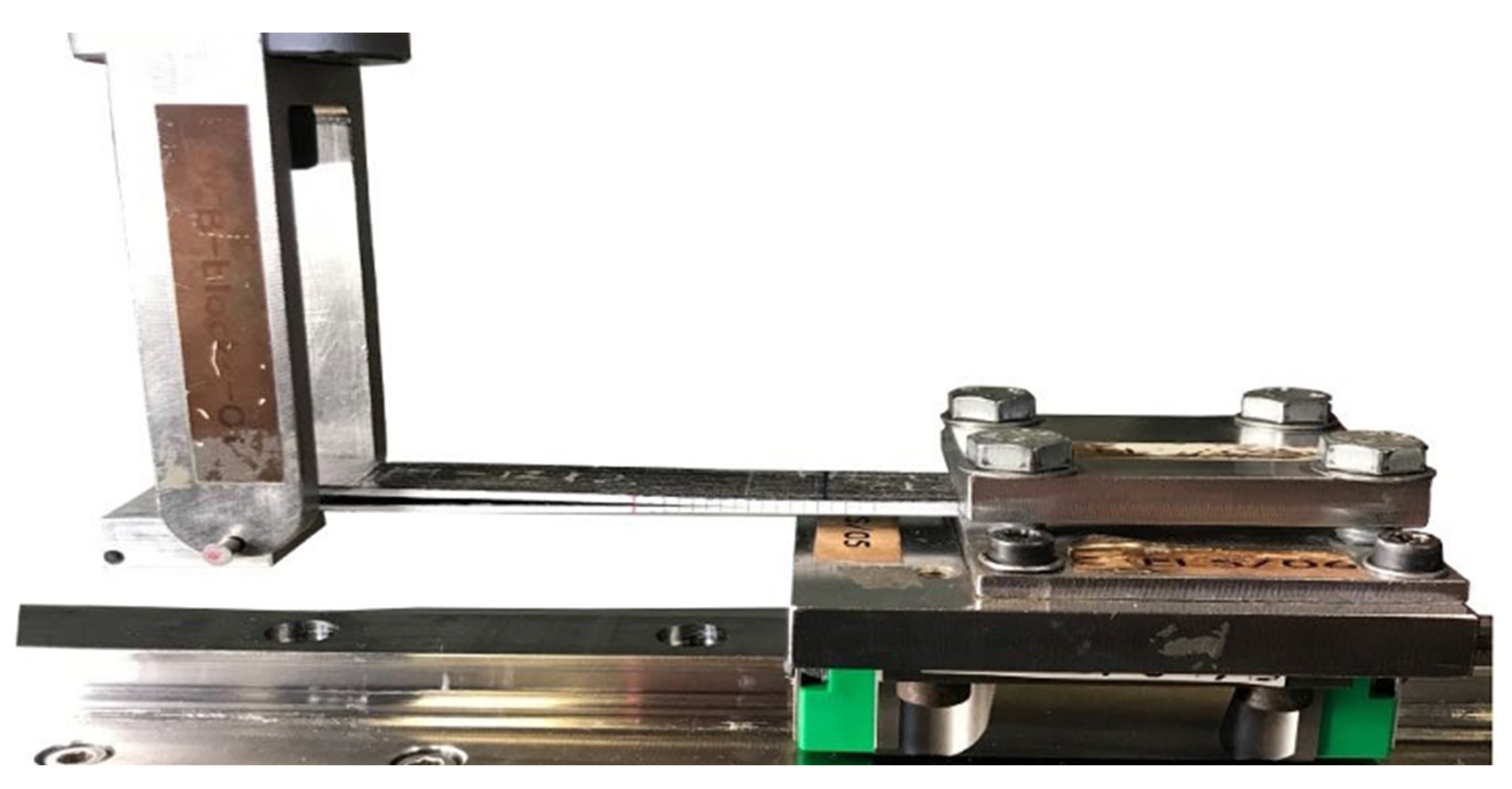
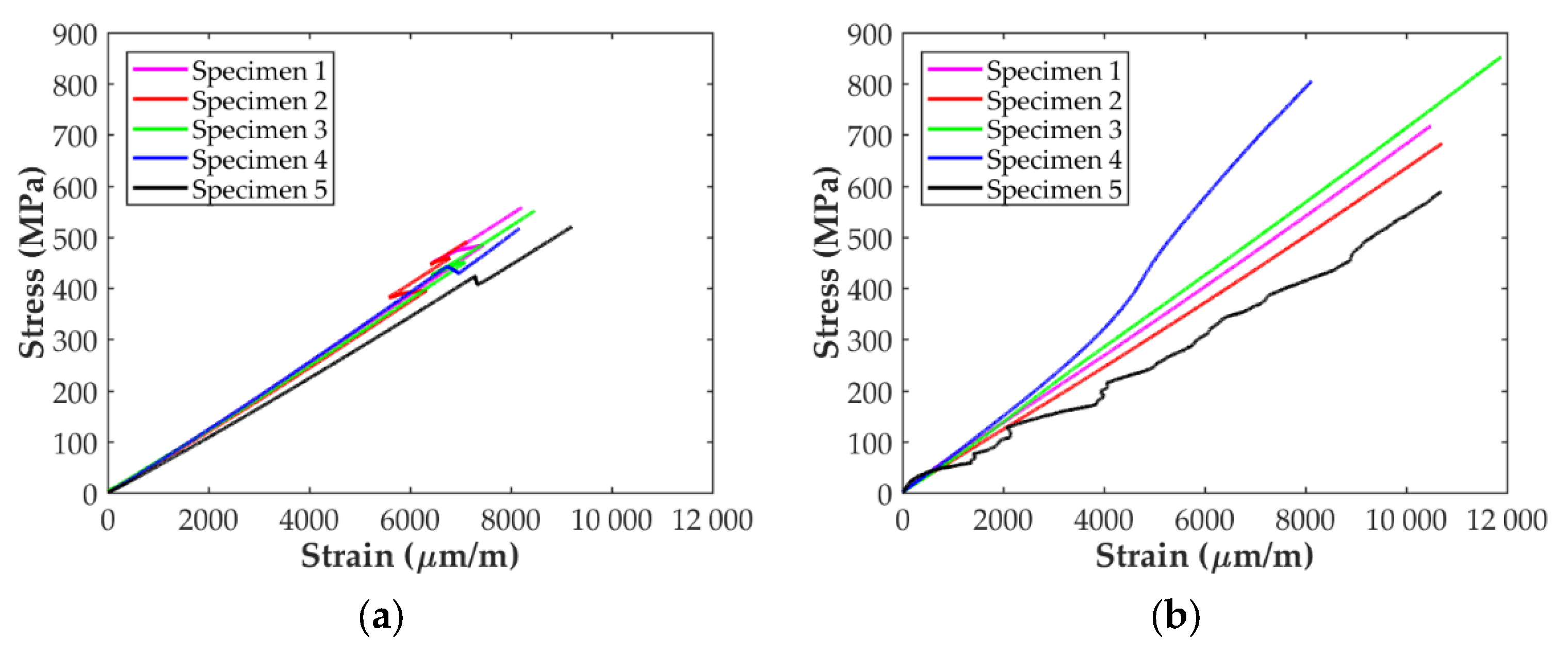
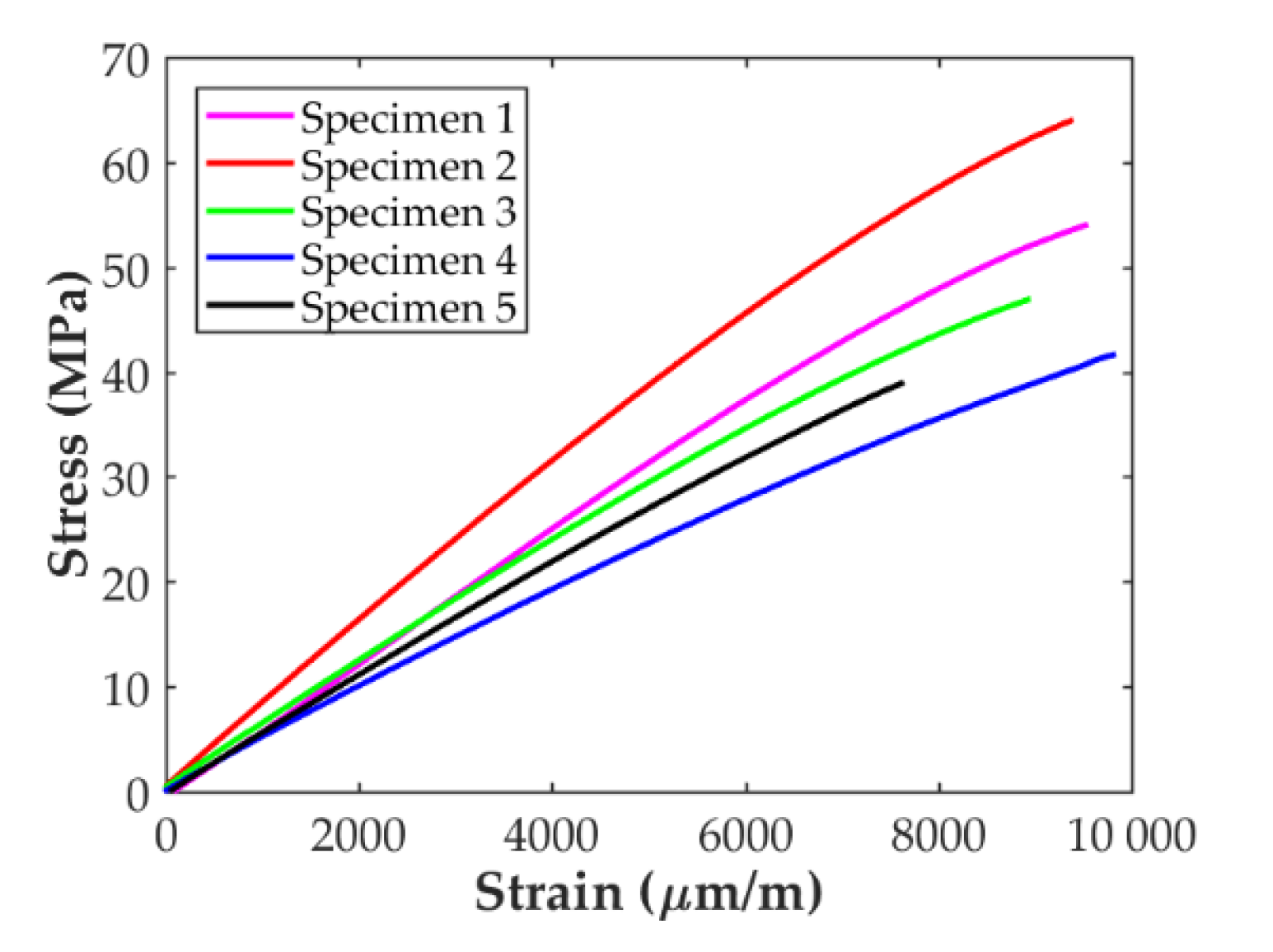
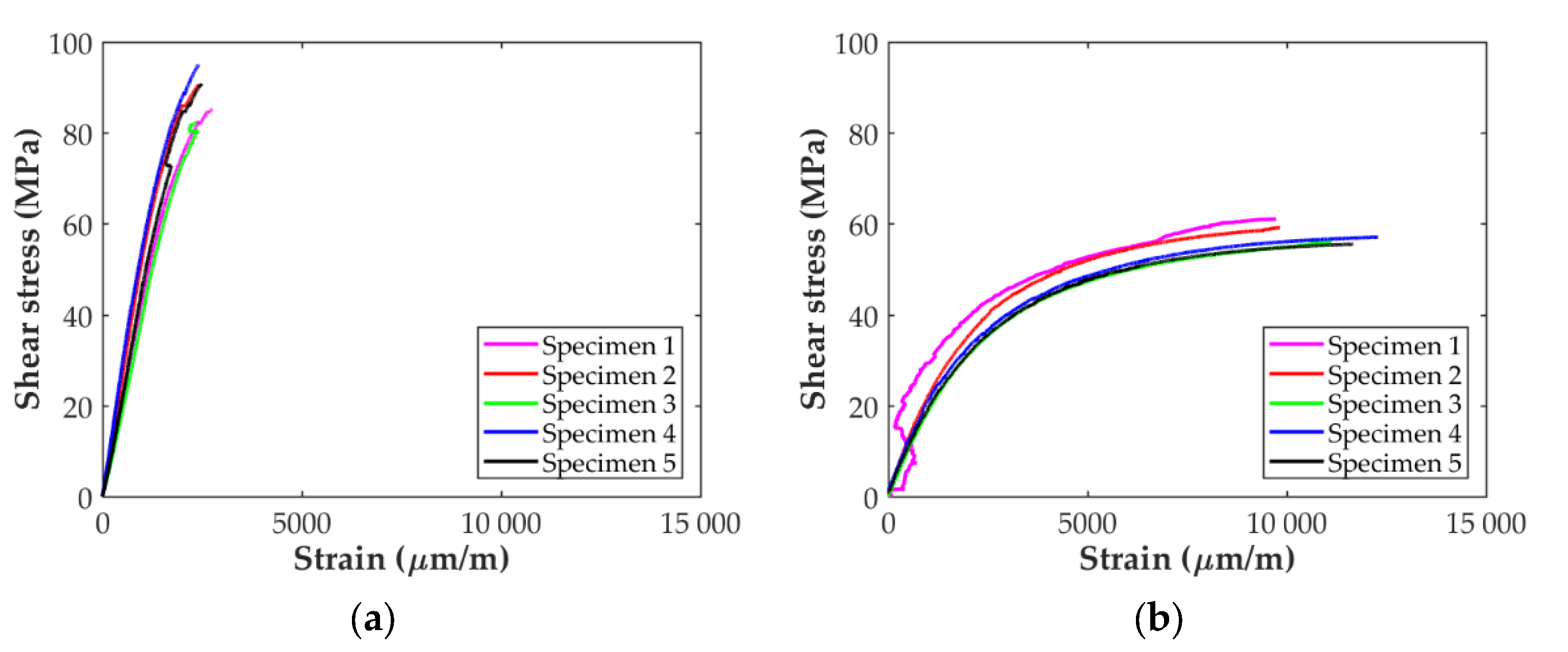
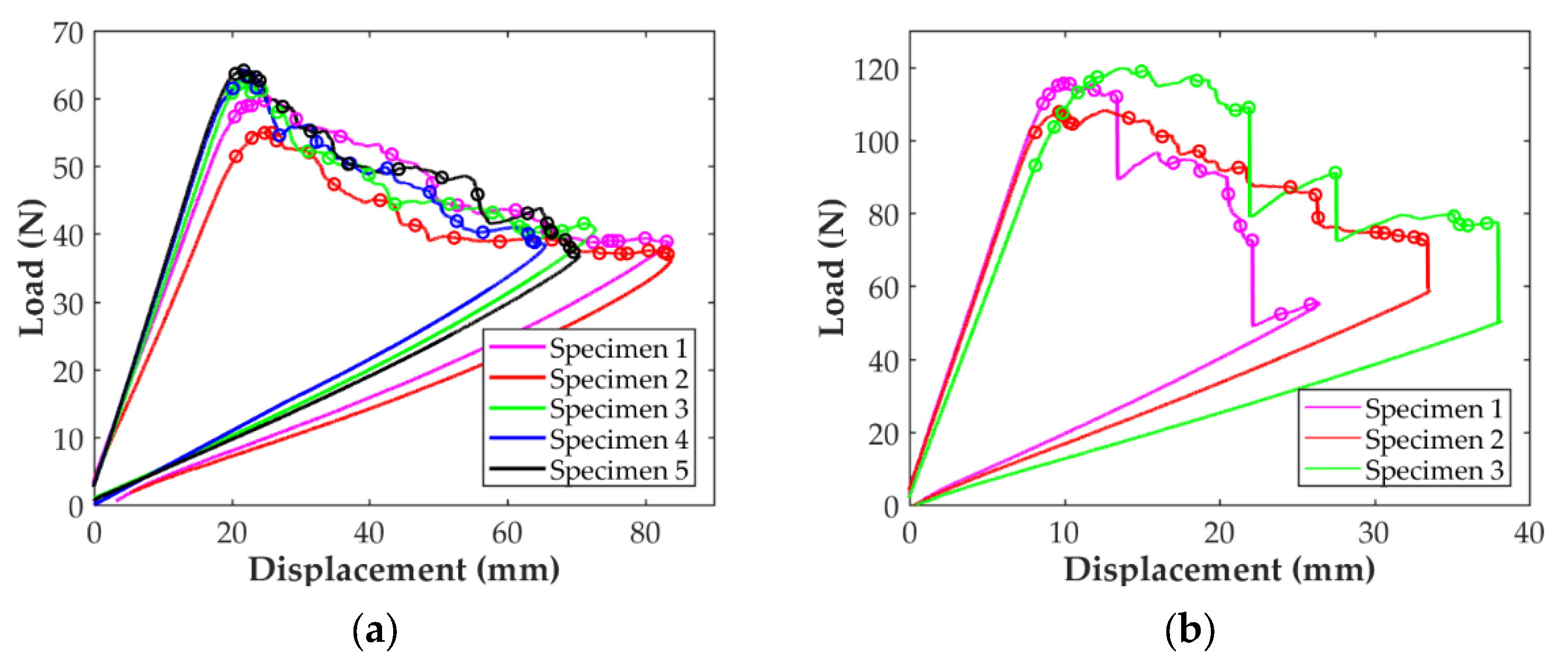
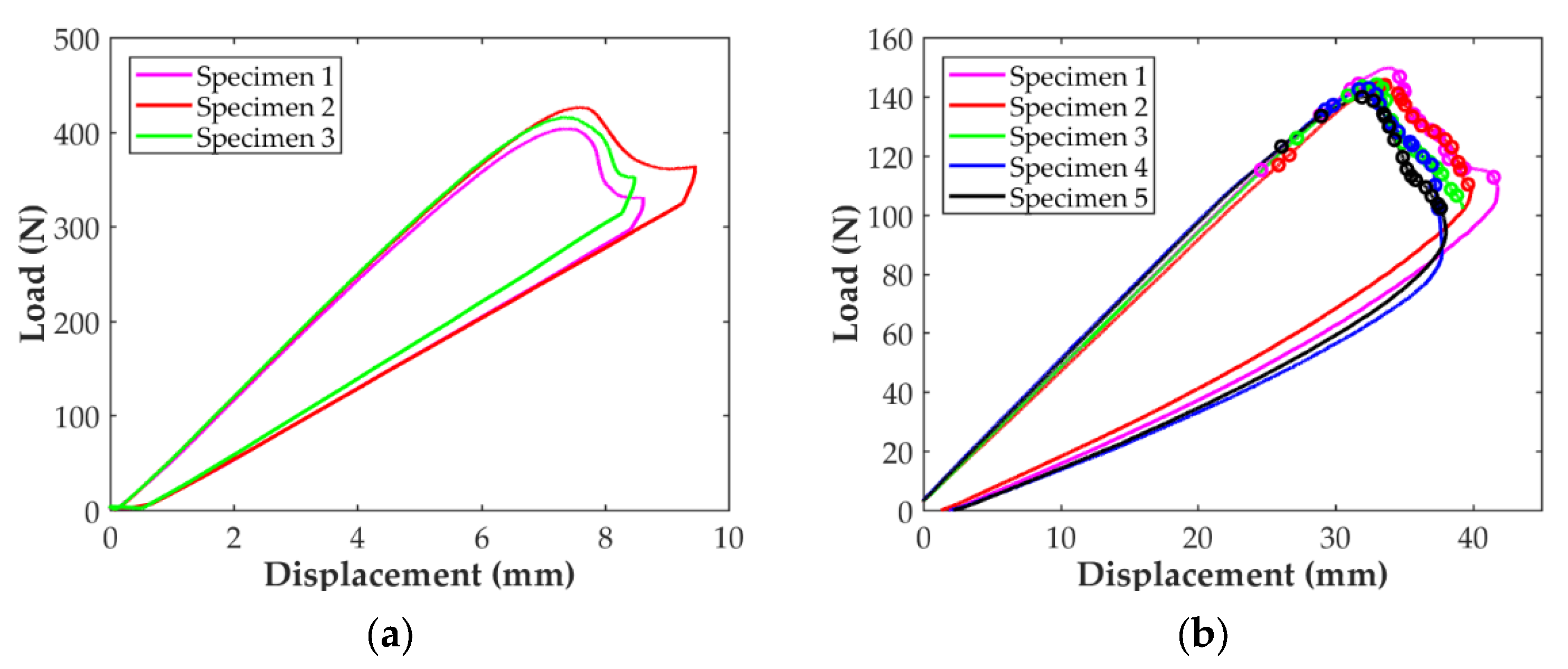



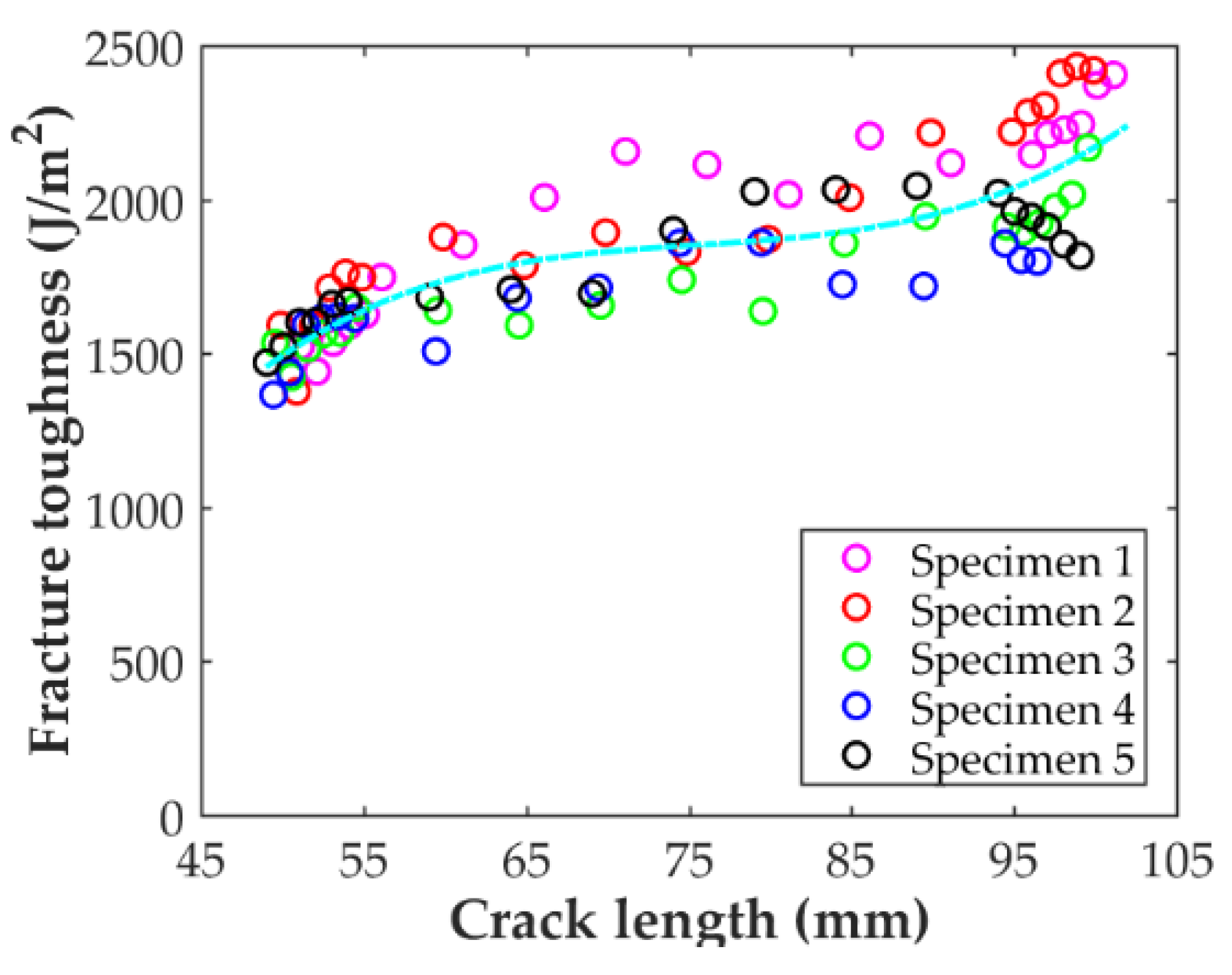
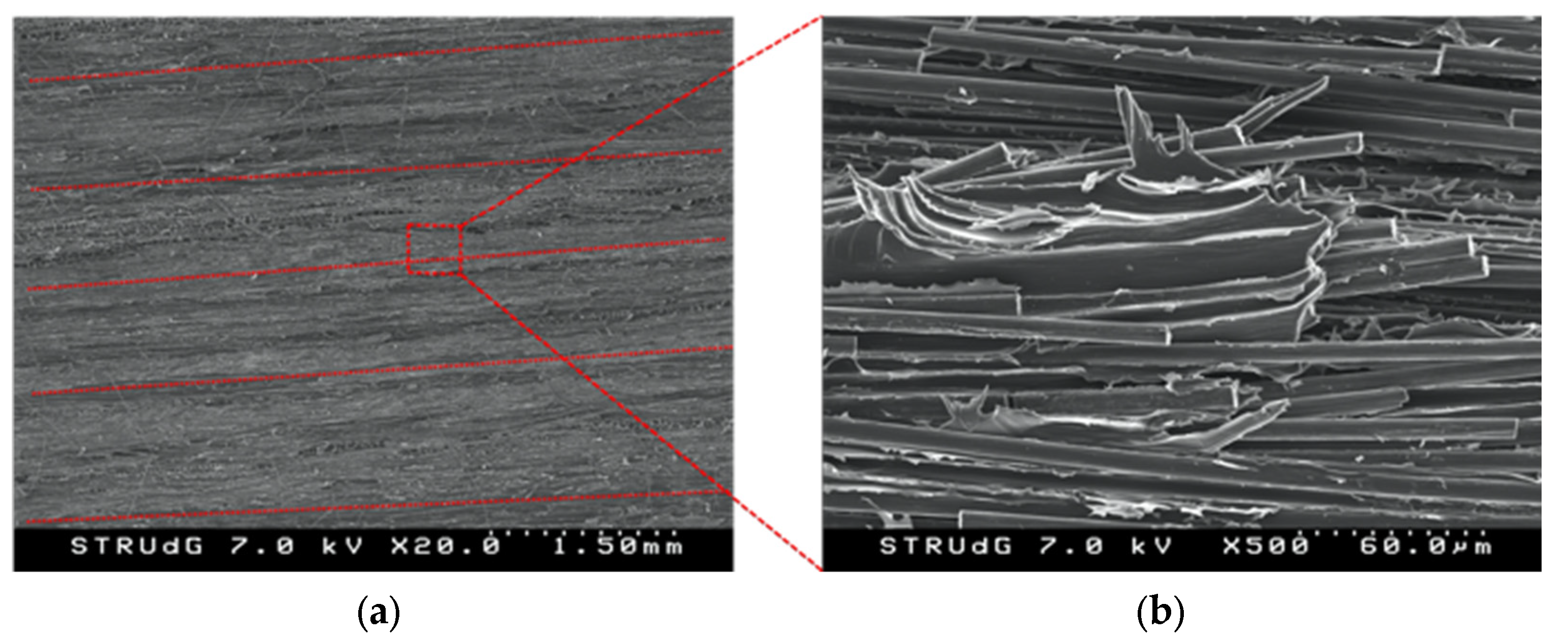
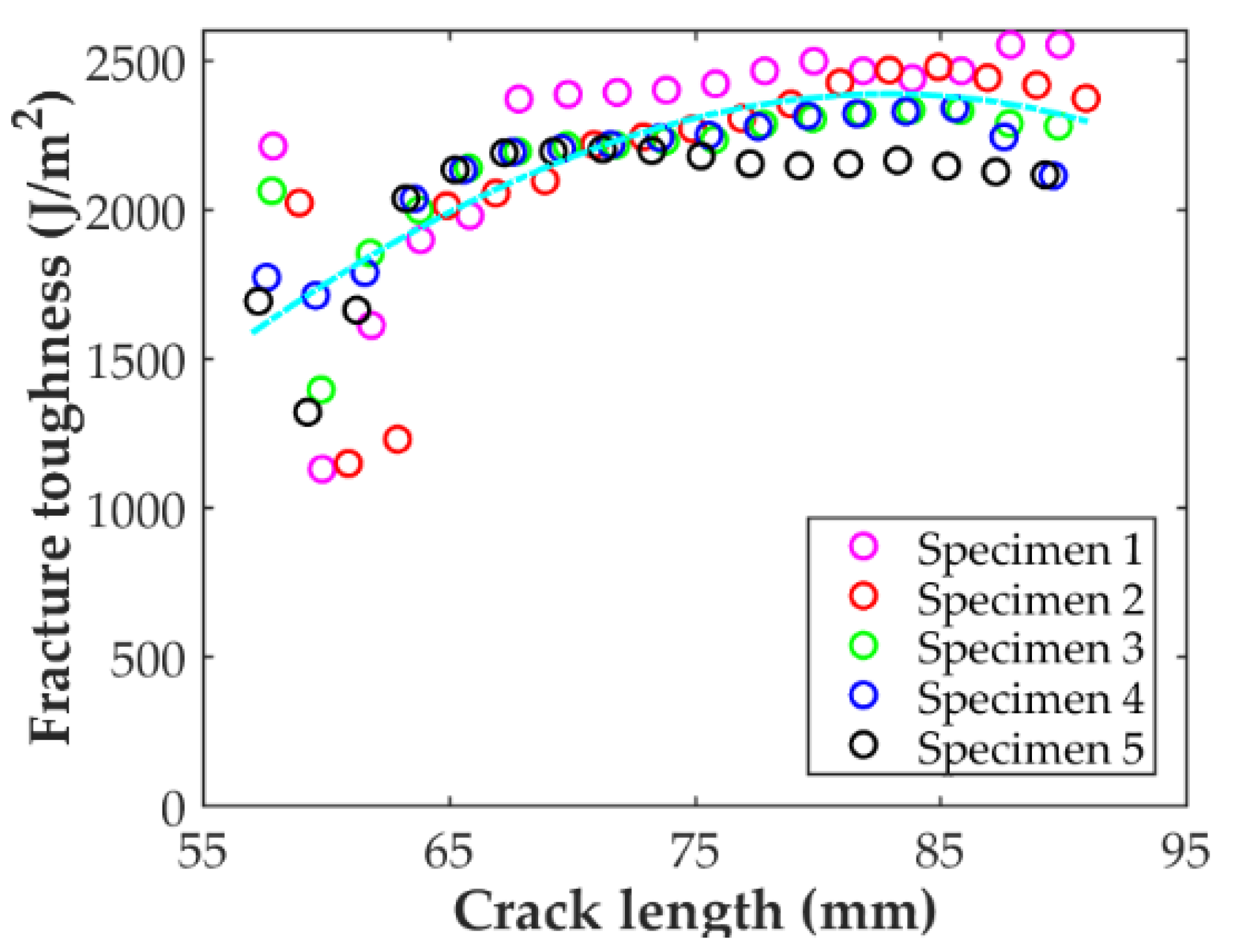
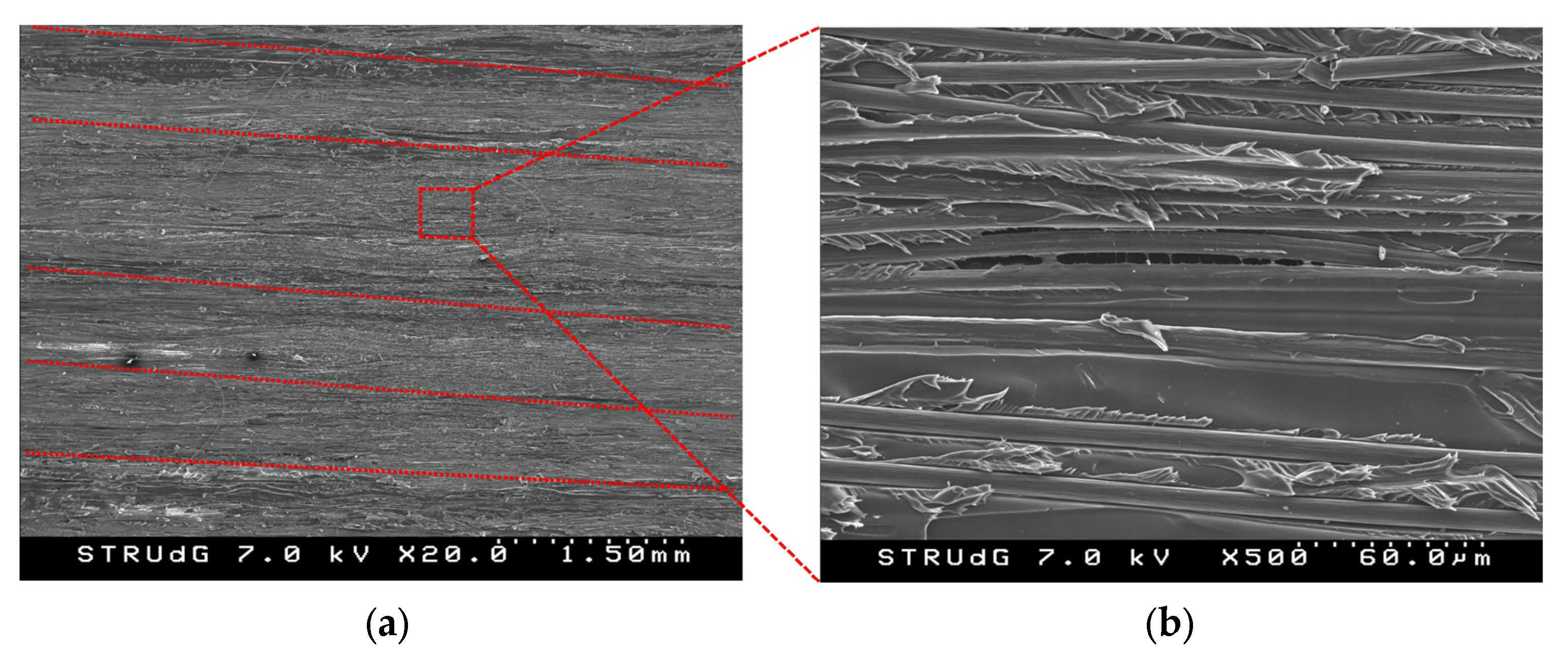
| Tensile Test | ASTM Standard | Lay-Up | End Tabs | Main Dimensions (mm) |
|---|---|---|---|---|
| Longitudinal | D638 | [N2/020/N2] | --- | 165 × 13 × 3 |
| D3039 | [N1/010/N1] | Paper | 250 × 15 × 1.5 | |
| Transverse | D638 | [N2/9020/N2] | --- | 165 × 13 × 3 |
| In-plane shear | D3518/D638 | [N2/±455s/N2] | --- | 165 × 13 × 3 |
| D3518/D3039 | [N1/±454s/N1] | Paper | 250 × 25 × 2.5 |
| Interlaminar Test | Standard | Lay-Up | Dimensions (mm) | Precrack (mm) |
|---|---|---|---|---|
| Mode I—DCB-A | ISO-15024 | [N4/012//012/N4] | 175 × 22.5 × 3 | 50 |
| Mode I—DCB-B | ISO-15024 | [N2/020//020/N2] | 175 × 22.5 × 5 | 50 |
| Mode II initiation | ASTM D7905 | [N1/011//011/N1] | 200 × 22.5 × 2.75 | 35 |
| Mode II | ISO-15114 | [N1/012//012/N1] | 175 × 20 × 3 | 65 |
| ASTM Standard | D638 | D3039 | |
|---|---|---|---|
| Longitudinal | Tensile modulus (GPa) | 57.1 ± 0.5 | 66.5 ± 7.1 |
| Poisson’s ratio | − | 0.39 ± 0.03 | |
| Tensile strength (MPa) | 528 ± 27.2 | 752 ± 88.6 | |
| Ultimate tensile strain (%) | 0.85 ± 0.05 | 1.10 ± 0.08 | |
| Transverse | Tensile modulus (GPa) | 6.16 ± 1.1 | − |
| Tensile strength (MPa) | 49.3 ± 10 | − | |
| Ultimate tensile strain (%) | 0.93 ± 0.07 | − | |
| ASTM Standard | D3518/D638 | D3518/D3039 | |
| In-plane shear | Shear modulus (GPa) | 4.87 ± 0.86 | 2.13 ± 0.17 |
| Shear stress at 5% (MPa) | − | 49.0 ± 2.0 | |
| Maximum shear stress (MPa) | 88.7 ± 4.9 | 56.9 ± 1.7 | |
| Maximum shear strain (%) | 2.49 ± 0.16 | 12.6 ± 2.3 |
| Fracture Toughness (J/m2) | |||
|---|---|---|---|
| Specimen | Data Reduction | Initiation | Propagation |
| DCB-A | J-integral | 1497 ± 85 | 1720 ± 116 |
| DCB-B | J-integral | 1064 ± 125 | 1265 ± 57 |
| ENF | CC | 1991 ± 80 | − |
| C-ELS | CBTE | 1950 ± 215 | 2307 ± 117 |
| Reference | E11 (Gpa) | E22 (Gpa) | G12 (Gpa) | Xt (Mpa) | Yt (Mpa) | S (Mpa) |
|---|---|---|---|---|---|---|
| Blok et al. [31] | 62.5 | − | 2.3 | 986 | − | 31 |
| Justo et al. [32] | 68 | − | − | 701 | − | − |
| Pyl et al. [29] | 58 | 1.5/1.8 * | 4 | 719 | 40 * | 48 |
| Chabaud et al. [33] | 60 | − | − | 534 | − | − |
| Iragi et al. [27] | 69.4 | 3.5 | 1.9 | 905 | 17.9 | 43 |
| Todoroki et al. [34] | 61 | 4/5 | 2.1 | 701 | 19/25 | 52 |
| Yogeshvaran et al. [35] | 54 | 12 | 5 | 860 | 19 | 25 |
| This work | 66.5 | 6.2 | 2.1 | 752 | 49.3 | 49 |
Publisher’s Note: MDPI stays neutral with regard to jurisdictional claims in published maps and institutional affiliations. |
© 2022 by the authors. Licensee MDPI, Basel, Switzerland. This article is an open access article distributed under the terms and conditions of the Creative Commons Attribution (CC BY) license (https://creativecommons.org/licenses/by/4.0/).
Share and Cite
Santos, J.D.; Fernández, A.; Ripoll, L.; Blanco, N. Experimental Characterization and Analysis of the In-Plane Elastic Properties and Interlaminar Fracture Toughness of a 3D-Printed Continuous Carbon Fiber-Reinforced Composite. Polymers 2022, 14, 506. https://doi.org/10.3390/polym14030506
Santos JD, Fernández A, Ripoll L, Blanco N. Experimental Characterization and Analysis of the In-Plane Elastic Properties and Interlaminar Fracture Toughness of a 3D-Printed Continuous Carbon Fiber-Reinforced Composite. Polymers. 2022; 14(3):506. https://doi.org/10.3390/polym14030506
Chicago/Turabian StyleSantos, Jonnathan D., Alex Fernández, Lluís Ripoll, and Norbert Blanco. 2022. "Experimental Characterization and Analysis of the In-Plane Elastic Properties and Interlaminar Fracture Toughness of a 3D-Printed Continuous Carbon Fiber-Reinforced Composite" Polymers 14, no. 3: 506. https://doi.org/10.3390/polym14030506
APA StyleSantos, J. D., Fernández, A., Ripoll, L., & Blanco, N. (2022). Experimental Characterization and Analysis of the In-Plane Elastic Properties and Interlaminar Fracture Toughness of a 3D-Printed Continuous Carbon Fiber-Reinforced Composite. Polymers, 14(3), 506. https://doi.org/10.3390/polym14030506








